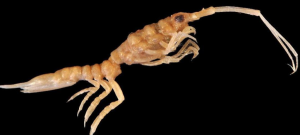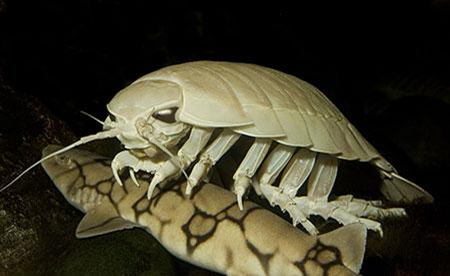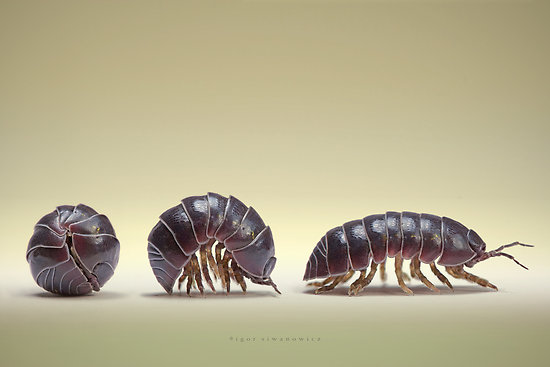Crustacean services and disservices
Author Mia Yockey
Co-Author Kimberly Cirilli
How we identified the organism:
We figured out the phylum was Arthropod due to it looking similar to that of an insect, with the segmented body and many legs. For figuring out it was an isopod with the dome- shaped it has on top of its body it has that was a big hint,where there are seven or eight legs instead of an insects six legs.
Picture of the unknown organism, for reference , Given by Dr.MCcluney
Similarities and differences of crustaceans and Isopods:
Isopods can live in the Ocean. freshwater and can live on land as well. This aspect also applies to crustaceans as well. A main difference for both crustaceans and Isopods is, Terrestrial members of this sub-phylum and order have thicker shells than those who live in aquatic environments. It is also segmented and armor like, this makes them able to roll into a ball,something aquatic Isopods can’t do. (Jonathan wright 2008)
A similarity between all crustaceans, is that they need water to survive. They need to be in a humid area and for some this can impacted by seasons. All crustaceans have gills as well, but this goes with Crustaceans needing water in order to survive. (Jon Wagler 2002)
For terrestrial isopods vs aquatic isopods, the Giant isopod and this weeks organisms are great examples of an aquatic isopod, smoother shell with less detail in the ridges. While the Wood louse will an excellent example of a terrestrial isopod with the rougher shell and detailed ridges. (Ron Wagler 2002)
I know this topics aren’t exactly services and disservices but I thought they were notable similarities and differences. Though one service of these is their help with research of Crustaceans and Isopods. Which I consider a pro for these facts.
Another difference is the dietary patterns between isopods with some being herbivores (Sowbugs and pill bugs), some are predators (Giant Isopod), or they could be parasitic (Tongue eating isopod) or scavengers (Pill bugs, since they eat a lot detritus). (Ron Wagler 2002)
Similarities for crustaceans is that they all an exoskeleton which is used for protection and helps when living in a pressurized environment such as the Ocean. All crustaceans have jointed legs as well, because this is a common trait of all arthropods. (Phil Myers,2000)
Giant Isopod, this image is used as a reference and to show the shell details of an aquatic Isopod (ugly animals: Giant Isopod)
http://ugly-animals.blogspot.com/2011/01/giant-isopod.html
Image of a Woodlouse, used for same purposes as the image above. This image also shows the contrast between the two (Wikipedia : Woodlouse)
https://en.wikipedia.org/wiki/Woodlouse
Services:
A service of the Isopoda comes from a very well know crustacean , the Pill bug or Roly poly as I called them when I was little. But these little guys benefit us by eating compose and detritus in our yards and help plants grow. This is especially helpful with those who love gardening and important for farming as well, Pill bugs can keep your plants healthy by keeping fertilizer in good condition. Another benefit of Roly Polies is that they help out help promoting restoration of areas of coal mining. Due to them being resilient to heavy metals, they can live in areas where mining occurs. They help clean up the soil making the areas (some of them at least), capable of supporting life again.(Jonathan wright 1997)
One easy service to pick out,is that crustaceans are used quite a bit as food. If one is to go to a fancy restaurant, chances are that Lobster, Crab and Shrimp will most definitely be on the menu. Crustaceans are also used in research because they are easy to work with, Crayfish are used a lot in this case. being a good beginning organism to work with.
Crustaceans are also really important to the food web, being a part of a lot of organisms diet and they are consumers as well. So they can help with keeping the food web in balance.
Crustaceans are also good indicators of environmental health, this is due to their shells. Their are studies that deal with Ocean acidification or acidification of any aquatic environment, Crustaceans are good indicators of the level of acidification. Their shells are key here, they can indicate the acid levels in the water. The hardness of their shells are how it’s done, if the shell is soft, then there is high acidity in the water. The opposite as well with a hard shell meaning little to no acidity in the water. (Kate Madin,2010)
https://sites.google.com/a/arlington.k12.ma.us/organisms/pill-bugs
I used an image of a pill bug here because I mentioned how it helps with gardening and farming.
Disservices:
Finding stuff for this section was a little difficult. but I did find a few things. The well known Rusty crayfish, a well known invasive species. An invasive species that’s been an issue in the Midwest for quite a while. The believed cause of these, is that Rusties are commonly used as bait, so live ones are releases into the wild. This causes a lot of ecological problems, the competition for food and living space,plus Rusty crayfish are very aggressive. (Seagrant 2008)
Pill bugs, even though they help keep plants healthy, this only applies to adult plants. Cause for budding plants ,they become a food source for the Pill bug, which can be a bug problem for gardeners and plant shops.(Jonathan wright 1997)
Those this next disservice effects animals more then people, it is still good to add I feel. The most well known parasitic isopod is the Tongue-eating isopod. That eats the tongues of fish, then basically replaces it so it can get the nutrients that the fish consumes as well. ( Mary Bates 2012)




